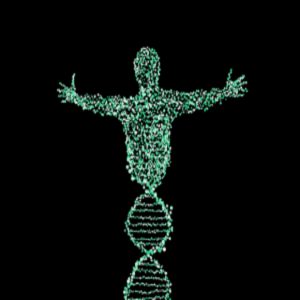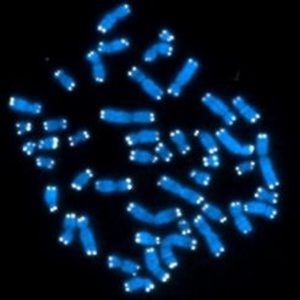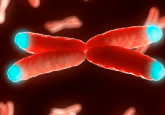Measuring the length of your telomeres can provide an insight to your biological age: fact or fiction?

Over-the-counter tests with claims to measure your biological age may be inaccurate.

It is has long been believed that measuring the length of your telomeres can provide an insight into your biological age, due in part to the shortening of telomeres across a cell’s life span as well as disease associations with shorter telomere length. Does a longer telomere really indicate a younger biological age?
If DNA is a shoelace…
Telomeres are located at the very ends of chromosomes, ensuring DNA is contained in its chromosomal shape and preventing DNA from coming apart during cell division. Imagine DNA is your shoelace and the telomere is the plastic tip at the end of it. The plastic tip prevents the shoelace from falling apart, maintaining its shape.
Telomeres become shorter after each time the cell divides, as they lose a section during each replication cycle. The telomeres then reach a point where they are too short to replicate anymore and the cell reaches a state of senescence. This is the point where a cell irreversibly stops dividing.
Normal telomeres can last an entire cell life span. However, there are occasions where the cells may age prematurely due to shorter telomeres that run out of excess material that can be lost more quickly. People with shorter telomeres can therefore develop different diseases, including pulmonary fibrosis, bone marrow failure, emphysema, liver disease and cancers. It is thought that at least 10,000 Americans may have diseases that are directly related to short telomeres.

Telomeres glow white at the ends of DNA. Credit: Johns Hopkins Medicine.
Let it flow
Mary Armanios, the clinical director of the Telomere Center at the Johns Hopkins Kimmel Cancer Center (MD, USA), said “these diseases affect as many people as certain types of leukemia, and we think the prevalence may be higher than current estimates.”
Armanios and her team utilized a pre-existing technique to accurately measure the length of telomeres, with the hope that they will be able to identify those with a higher risk of developing disease associated with short telomeres.
“Our goal was to establish a clinically reliable tool for telomere length measurement in a hospital setting and make it available to physicians and their patients for precise diagnosis and treatment recommendations,” explained Armanios.
“Typical clinical findings and current tests are not likely to identify most patients with very short telomeres,” she continued. “So, there is a need for molecular tests to diagnose this condition, especially since these patients in hospital or clinical settings are more susceptible to side effects of routine medications and procedures.”
The technique is termed “flow-FISH”, standing for flow cytometry and fluorescence in situ hybridization and measures telomere length in each cell in a patient’s blood sample. Small holes are made in the nucleus of each cell in the sample and fluorescently labelled DNA is then attached to the telomeres. Flow cytometry is then used to identify the different types of cells and quantify the fluorescent signals from each individual cell.
The researchers utilized the test to determine a normal telomere length range across 192 healthy people, from newborn to 82 years old. They compared these results with the same test involving 444 healthy people in Vancouver (BC, Canada). The values were similar – within 5% of each other – demonstrating that the test can be reproducible and accurate as a telomere length measurement tool.
Telomere length was measured in 100 people from 60 families who carried genetic mutations connected to telomeres and telomerase. Of the 100, 73 people had symptoms of diseases associated with short telomeres and those with the shortest telomeres did tend to develop symptoms at a younger age.
The results show that accurate telomere length measurements can be utilized in a clinical setting to identify patients and provide advice and treatment best suited for their specific needs.
Molecular palm reading
It is possible to purchase telomere length measurement tests for 100USD over the counter, which claim to provide a measure of your biological age. These tests involve the use of qPCR and collect the cells in a patient’s blood sample, extracting and amplifying the DNA and measuring the number of repetitive DNA sequences.
Research has claimed to prove that these tests are inaccurate, as the results can vary by up to 20% depending on the day the test is performed and the lab the test is carried out in.
“Within the normal telomere length range, it is not possible to determine a person’s exact biologic age, nor is it a good marker of a person’s youthfulness,” Armanios explains.
“In addition, the idea that very long telomeres are better for your health may not be true. Evidence suggests that such lengthy telomeres may be associated with greater cancer risk.”
Armanios details personal experiences in which people have called her in panic after receiving results from these tests. One such experience was a man in his 40s who was told his telomeres were that of an 80 year old. He sold his house, quit work as well as delaying surgery for a precancerous skin spot, as he believed the surgery would also shorten his telomeres.
“These kinds of tests can do harm, suggesting there is something wrong when there isn’t.”
“The telomere belongs in the clinic,” Armanios says, “and should not be used as a form of molecular palm reading.”
To conclude, whilst shorter telomere length is an indicator of an aging cell and potential increased risk of disease, longer telomeres may also be indicative of certain diseases. On top of that, tests that claim to provide an accurate measure of telomere length and hence biological age are likely to be inaccurate and should be taken with a pinch of salt.




